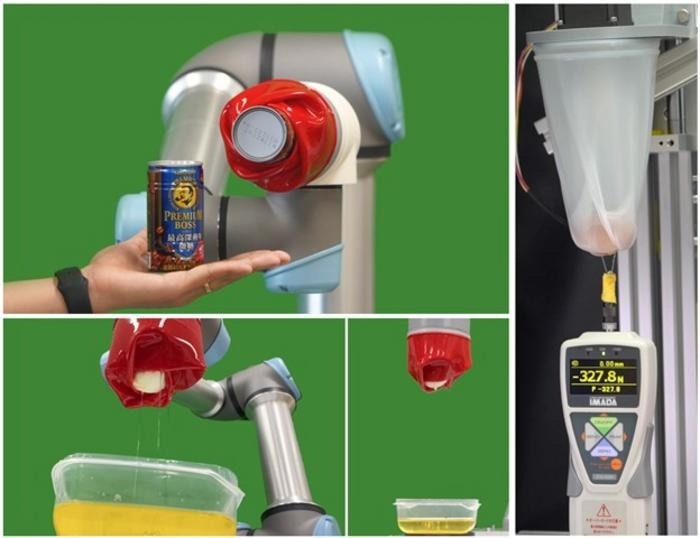
ROSE can pick up a wide variety of objects with ease. The top-left image shows it grasping a coffee can, whereas the bottom images show it successfully picking up a peeled chicken egg submerged in olive oil. The image on the right shows the maximum lifting force that ROSE can withstand. Image Credit: Van Anh Ho from Japan Advanced Institute of Science and Technology.
Picking up an object requires fine control of the fingers, their positioning, and the pressure each finger applies, which demands intricate sensing abilities. It is hardly surprising that grasping and manipulation are highly active research areas in the field of robotics.
So far, industrial robotic hands have replaced humans in several complicated and risky activities, such as in restaurants, factories, farms, and manufacturing plants. Overall, soft robotic grippers are ideally suited for tasks in which the objects to be picked up are delicate, like vegetables and fruits.
But while soft robots are considered to be hopeful as harvesting tools, they generally share a common drawback: their price tag. The majority of the soft robotic gripper designs need the intricate assembly of several pieces. This brings up development and maintenance costs.
Luckily, a research group from the Japan Advanced Institute of Technology (JAIST), headed by Associate Professor Van Anh Ho, has devised an innovative solution to such problems.
Taking a leaf from nature, they have developed an innovative soft robotic gripper known as “ROSE,” which refers to “Rotation-based Squeezing Gripper.” Details regarding ROSE’s design, as well as the outcomes of their latest study, have been presented at the Robotics: Science and Systems 2023 (RSS2023) conference.
What makes ROSE so impressive is its design. The soft gripping part has the shape of a cylindrical funnel or sleeve and is connected to a hard circular base, which in turn is attached to the shaft of an actuator.
The funnel must be placed over the object meant to be picked up, covering a decent portion of its surface area. Then, the actuator makes the base turn, which drives the adaptable funnel’s skin to wrap closely around the object, as shown in this video. This mechanism was loosely motivated by the altering shapes of roses, which bloom during the day and close up during the night.
ROSE provides significant benefits compared to highly traditional grippers. Initially, it is much less costly to manufacture. The hard parts could all be 3D-printed, whereas the funnel itself can be produced easily with the help of a mold and liquid silicone rubber. This guarantees that the design is easily scalable and ideal for mass production.
Second, ROSE has the potential to easily pick up an extensive range of objects without complicated control and sensing mechanisms. Compared to grippers that depend on finger-like structures, ROSE’s sleeve applies a milder and more uniform pressure.
This makes ROSE ideal for handling fragile produce, like pears, strawberries, and slippery objects. Weighing below 200 g, the gripper could potentially obtain a splendid payload-to-weight ratio of 6812%.
Third, ROSE is known to be extremely tough and sturdy. The team displayed that it could effectively continue to pick up objects even after performing 400,000 trials. Furthermore, the funnel still functions properly in the existence of considerable cuts or cracks.
The proposed gripper excels in demanding scenarios, as evidenced by its ability to withstand a severe test in which we cut the funnel into four separate sections at full height. This test underscores the gripper's exceptional resilience and optimal performance in challenging conditions.
Van Anh Ho, Associate Professor, Japan Advanced Institute of Science and Technology
Eventually, ROSE could be endowed with sensing abilities. The scientists achieved this by positioning multiple cameras on top of the circular base, thereby pointing at the inside of the funnel covered in markers, whose position can be picked up by the cameras and examined via image processing algorithms. This promising method enables for size and shape estimation of the grasped object.
The research team notes that ROSE can be an attractive option for several applications, such as harvesting operations and sorting items in factories. Also, it could find a home in cluttered environments like professional kitchens, farms, and warehouses.
The ROSE gripper holds significant potential to revolutionize gripping applications and gain widespread acceptance across various fields. Its straightforward yet robust and dependable design is set to inspire researchers and manufacturers to embrace it for a broad variety of gripping tasks in the near future.
Van Anh Ho, Associate Professor, Japan Advanced Institute of Science and Technology